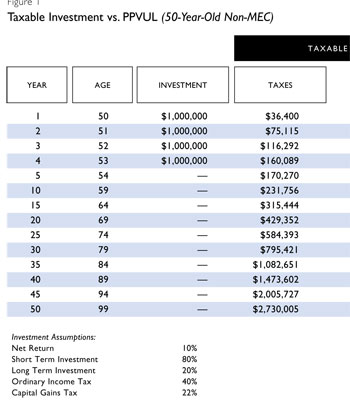Private placement policies are also "universal" policies, meaning that after the first premium payment there are no mandatory payments required as long as there are sufficient assets to pay for the cost of insurance on the policy and other current charges. Private placement policies usually require minimum premium payments on the order of several million dollars, and premium payments can stretch over several years.
Once the insurance company receives the premium and the funds are allocated to one or several managers or IDFs, the policy owner is generally permitted to change managers or select new funds at periodic intervals. Such changes or reallocations are tax-free so that the gains derived on the sale of one fund are available in full for an allocation to a new fund. Moreover, the administrative charges for the changes are minimal or nonexistent.
Loan Opportunities
Private placement investors can borrow from the policy if it is structured as a non-modified endowment contract. The funds may be borrowed at market interest rates without any tax effects. The loans do not have to be repaid during the lifetime of the borrower and may be repaid tax-free out of the proceeds of the policy upon the death of the insured.
Private placement deferred variable annuities operate in the same fashion as life insurance policies during the lifetime of the owner in that gains accrue tax-free. Distributions are taxable, however, at ordinary income rates, generally over the lifetime of the annuitant starting in the first year after the deferral period. Distributions are apportioned between income and the return of capital. The period of deferral can be continued where the beneficiary of the policy is a spouse and taxes can be avoided if there is a charitable beneficiary. Gains distributed to an annuitant who has not reached the age of 59½ are subject to an additional 10% penalty tax. The advantage of an annuity is that it does not require underwriting-there is no life insurance component, which means that it can be issued quickly. Moreover, the cost of an annuity is less since there is no insurance risk.
The assets of most private placement policies are held in segregated accounts, which protect the owners from creditors of the insurance carrier. This also eliminates the risks associated with comingled accounts and assets. Each policy account stands alone and is not part of the carrier's general account.
The costs of private placement policies are generally small in light of the benefits. In the case of life insurance, a portion of the cost is based on the age, sex and health of the insured. In addition, each policy covers an administrative charge, typically called a mortality and expense fee. Notwithstanding these charges, the costs of a private placement policy are far lower than the costs of a conventional insurance policy. Private placement policies have minimal distribution costs, such as commissions and other policy loads. Conventional policy loads can range from 60% to 70% of the first-year premium. Also, mortality and expense charges are generally lower so that the total policy loads-exclusive of the costs of insurance risk-rarely exceed 100 basis points per year on the assets under management. (See Figure 1.)

There are two important rules regarding investments made within a private placement policy. First, the investments must be diversified. Internal Revenue Code Section 817(h) allows no more than 55% in one underlying investment, 70% in two investments, 80% in three investments, and 90% in four investments if the investments are not an IDF. An IDF is given "look through" treatment, which means the fund will not be viewed as a single, concentrated investment. When the policy invests in a managed account, each hedge fund investment by the manager will be considered an investment in a single security, so at least five hedge fund investments will be required. Second, the policy owner is prohibited from directly controlling the investments in the account. The owner may select a third-party manager or an IDF. The manager may be required to follow certain investment guidelines but may not be directed to make specific investments. Policy owners may not communicate directly with the account managers about account management, though transparent reporting may be required.
The investor control rules comes into play if a manager wishes to invest in his or her own fund through a private placement policy, or if an investor wishes to invest in closely held securities through a policy. In both cases, the investments would have to be treated as being directly owned by the policy owner and not by the insurance policy. But this would eliminate the tax benefits of investing through a private placement policy.
Private placement policies are available through a small number of insurance carriers, both domestic and foreign. There are important differences between the two. Foreign carriers are generally prohibited from marketing their products in the U.S. by state insurance laws. Consequently, U.S. citizens may only purchase policies from a foreign carrier while outside the U.S. This generally means that all aspects of the transaction-including completing the application, executing documents and receiving illustrations and the policy-must occur outside the U.S. Private placement policies issued by a domestic carrier may be purchased in a state where the carrier is admitted to do business.








